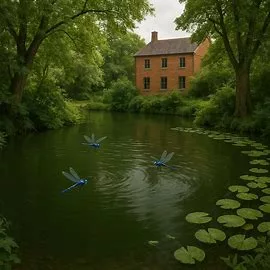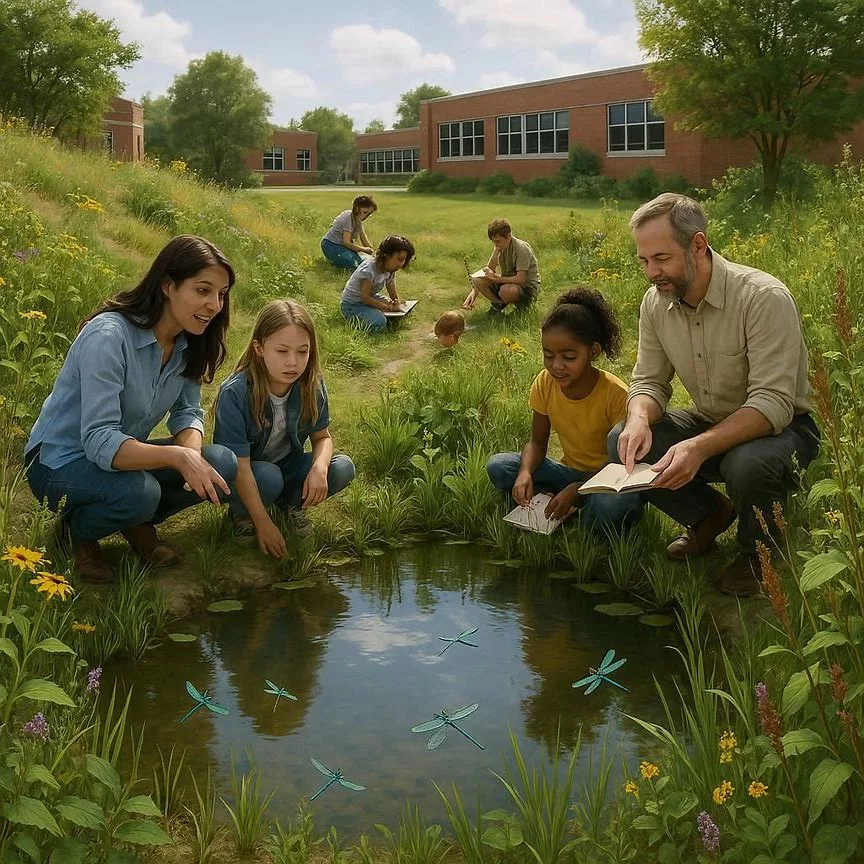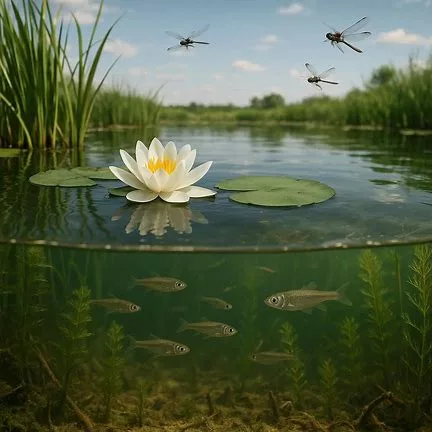Rewilding Schoolyard Ponds For Native Dragonfly Resurgence
School Pond Education Benefits
Most importantly, schoolyard ponds go beyond scenic beauty and aesthetic. They are an excellent way to teach and promote biodiversity locally and on school grounds. In my formative years, none of the schools I attended had a pond. It was only when I arrived at Rutgers University, that I experienced the wonders of having a pond on campus. It was a relaxing place where where I and other students could study, enjoy and observe nature.
Currently, schoolyard ponds have seen better days, often overlooked and lacking that crucial touch of biodiversity. These small but mighty ecosystems can transform into bustling habitats with just a bit of care and attention. Talking about native dragonfly species, they’ve been a steady presence for centuries, serving as wonderful indicators of environmental health due to their sensitivity to changes in water quality and habitat conditions.

Here is an interesting fact, dragonflies are more than just pretty wings and nimble flight paths; they’re the unsung heroes of aquatic ecosystems. Their presence signals a thriving environment, warning us about issues like water contamination before they spiral out of control. Historically, these insects have been plentiful, but urban development and habitat destruction have taken a toll.
This is why, rewilding schoolyard ponds taps into a legacy of ecological harmony. By restoring these habitats, we not only invite back native dragonfly species but also support a host of other plants and animals that depend on them. It’s a win-win, enhancing the local ecosystem’s resilience while also turning school ponds into vibrant learning environments. I certainly celebrate creating a space where nature and education come together in the most delightful way.
How Do You Create a School Yard Pond?
Lets dive into implementing effective rewilding strategies and best practices for school pond ecology. Creating a dragonfly-friendly haven in your schoolyard kicks off with a strategic approach. It’s all about getting the essentials right, starting with developing a good habitat. Listed below is the basics.
- You need a pond that’s not too deep or too shallow. This should be about knee-height is perfect for dragonfly larvae to thrive. Don’t forget gentle sloping banks to allow easy ingress and egress. Understanding what is a school yard pond is part of the crucial.
- Choosing the right plants can make or break your rewilding efforts. Native aquatic plants are a must. They provide perfect perching spots and hideouts for dragonflies and their prey. A mix of submerged, floating, and emergent plants will create a balanced ecosystem. Think of it as building a dream home for dragonflies, complete with all the amenities!
- Bringing students and teachers into the rewilding adventure is vital. It becomes more than just a project; it’s a community effort. Encourage them to participate in planting and monitoring biodiversity. This hands-on experience not only enriches their understanding of ecology but also instills a sense of responsibility and pride.
- It is important to note that challenges may pop up, like algae overgrowth or invasive species, but don’t be discouraged. They are part of the learning curve. Regular maintenance and a keen eye ensure your rewilding efforts stay on track. Persistence pays off and there’s plenty of advice from local environmental groups that can help guide you through rough patches.
Please click on the below link for more information and education resources on this courtesy of The Jersey Bio Diversity Centre
https://jerseybiodiversitycentre.org.je/resource/pond-activity-ideas
School Pond Learning Experiences
This is the best part, in my opinion. Witnessing the change and the impact of rewilding on ecology and education. Nothing beats seeing the fruits of your labor as dragonflies start to crowd your revamped or new pond. Successful rewilding efforts in schoolyards are not just stories of ecological rejuvenation; they’re proof that students can become true stewards of nature. When native dragonfly populations flourish, it’s a clear sign that your little pond is doing its job as a healthy, sustainable ecosystem.
Furthermore, case studies from schools that have embraced rewilding show a dramatic increase in local biodiversity. They serve as inspiration and offer a blueprint for others looking to jump in. Measuring the ecological impact involves observing not just the resurgence of dragonflies but also an increase in other aquatic life and native birds that come to visit.

Most importantly, the educational benefits of these projects can’t be overstated. By participating in the rewilding process, students gain a tangible sense of achievement and pride. They learn about ecosystems, the importance of biodiversity, and even develop vital skills in scientific inquiry and environmental management. It’s a chance for them to connect classroom knowledge with real-world applications in the coolest way possible.
Bringing Things Together
In conclusion, to keep these changes lasting, think long-term. Regular assessments and adjustments will ensure the school garden pond remains a thriving environment. Encourage continuous student involvement by setting up eco clubs or science classes centered around the pond. This kind of ongoing engagement secures not just the health of the pond but cultivates a growing interest in ecology among students and understanding school pond ecology.
